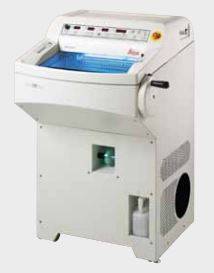
Description
The Leica Cryostat (CM1950) basic instrument is equipped with CryoZone technology, and encapsulated microtome with specimen orientation. The instrument can be ordered with various options including actively cooled object head (dual compressor), motorized sectioning drive, vacuum section waste removal system, and wide range of accessories.
The Leica Cryostat is a semi-motorized (motorized specimen feeding), high-performance cryostat with an option for motorized sectioning. It is used to freeze and section varying human specimen material quickly. These sections are used for histological medical diagnosis by a pathologist, e.g., for cancer diagnosis. The Lecia Cryostat is suitable for in-vitro diagnostic applications. The instrument may only be operated within the scope of its intended purpose as described above and as per the instructions given in these Instructions for use.
Capabilities
- Cryochamber temperature range 0°C to -35°C ± 5K. adjustable in 1K increments, at ambient temperature of 20°C.
- Object head cooling temperature range -10 to -50 °C ± 3K.
- Quick-Freeze shelf lowest temperature range -42 °C (±5K), at chamber temp. -35 °C (+5K)
- Peltier element Max. difference in temperature to quick-freeze shelf -17K, at chamber temperature of -35 °C +5K.
- Microtome type rotary microtome, encapsulated.
- Section thickness range 1 to 100 μm.
- Trimming thickness range
- Clinical: 10 to 40 μm
- Research: 1 to 600μm
- Horizontal specimen feed 25mm + 1mm.
- Vertical specimen stroke 59mm ± 0.5mm.
- Maximum specimen size 50 x 80mm.
- Sectioning speed
- Slow: 0 to 50 strokes/min
- Fast: 0 to 85 strokes/min
- Max speed: 85 to 90 strokes/min
- Specimen orientation ±8 ° (x-, y-axis)
- Coarse feed
- Slow: 300 μm/s
- Fast: 900 μm/s
Related Equipment
Which 'tome is right for me?
Location: Supple 171
Manager: Dr. Casey Smith, casey.smith@txstate.edu
Trainer: Josie Padilla, hvh21@txstate.edu.
Model: Leica Cryostat (CM1950)
